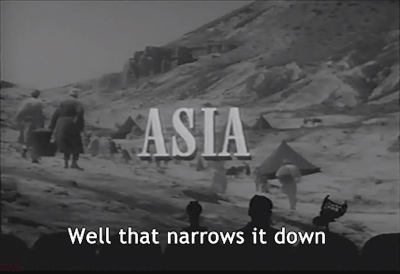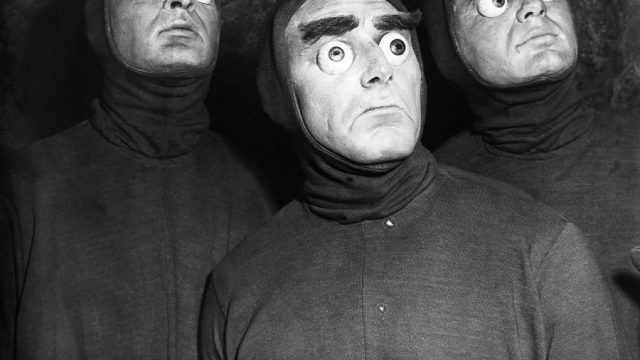I was just a few parenting choices away from becoming a Monster Kid. When I was very young, I devoted myself to learning all I possibly could about animals. After a year or two, I was somehow convinced I had gotten as far as I could with real ones, so I moved onto the imaginary ones. I studied creatures from fairy tales, myths, the menageries of Dr. Seuss…and, of course, the movie monsters. I pored through my parents’ Videohound Golden Movie Retriever for descriptions of colorful creatures like The Manster and The Aztec Ape. But my parents kept a close eye on my video rentals, and the age of the late-night monster-movie show was long dead, even if our backwoods home had gotten any TV reception. But what child wouldn’t be tempted by taglines like these?
IT MAULS…IT RIPS…IT VANISHES!
10,000 TIMES STRANGER THAN THE WILDEST FICTION!
SIGHTS TOO WEIRD TO IMAGINE! DESTRUCTION TOO MONSTROUS TO ESCAPE!
MORE! MORE! MORE! SEE EVERY SCREEN-SHATTERING THRILL!
SEE IT — BUT DON’T REVEAL IT!
Of course, only a few of them could live up to the hype. But 1954 was a good year to be a monster kid: drive-ins were stuffed with the best and worst the genre could offer. Godzilla was ground zero for the Japanese sub-subgenre of kaiju films, and Them! codified the formula of their American equivalent, while Creature from the Black Lagoon would, like his Japanese cousin, transcend B-movie camp with a kind of moody poetry.
Their competition, meanwhile, was something far short of transcendent. But some, like Killers from Space, are the best kind of bad. For most of its runtime, Killers is a pretty conventional thriller, sometimes gripping, sometimes boring. Future Airplane! star Peter Graves plays a nuclear scientist who mysteriously survives an equally mysterious plane crash as he’s flying over an atomic bomb test. His superiors are understandably suspicious when he walks away without a scratch except for some stitches over his heart, and even more suspicious when he claims he can’t remember anything after the crash. He starts stealing state secrets, apparently on the orders of a pair of glowing eyes he sees floating in front of him. It’s a good, creepy effect, and it might explain why director-producer W. Lee Wilder thought the design of his aliens might work.
It doesn’t. These bug-eyed monsters look less otherworldly horrors than like somebody you’d see frolicking down Sesame Street with Ernie and Bert — they even have Bert’s big, bushy eyebrows! And against all odds, no matter how many times they appear onscreen, the joke never gets old. Sometimes the eyeballs get stuck facing opposite directions, making the aliens look goofy chameleons. Other times, you can see they’re about to fall out as soon as Wilder yells “Cut!” And the skintight pajamas don’t help either. These Muppety monstrosities aren’t the only creatures Killers from Space has to offer, though. When the aliens take Graves prisoner, they imprison him in a dungeon full of all kinds of horribly mutated earth animals. Or, more accurately, out-of-focus projections of normal earth animals that Graves runs around and around the same cavern set to get away from.
On the other hand, Wilder’s other 1954 feature, The Snow Creature, is the worst kind of bad: the kind that doesn’t even have the decency to be entertaining by accident. There’s some camp potential in the creature itself, a Himalayan yeti portrayed by a stuntman in a baggy suit, most commonly seen as a disembodied hand that looks like an oven mitt made out of Grover’s pelt (I wonder if a young Jim Henson could have been watching these movies and taking notes). Unfortunately, Wilder is too smart for his own good. Apparently recognizing how laughable his star was, he keeps him offscreen as much as possible, instead padding out the run time with endless scenes of regular ole human beings wandering around in dead, awkward silence. At first, The Snow Creature promises something more interesting. Like many of 1954’s monster movies, it opens with some documentary-lite footage to set up the setting and ground its fantasies in some extremely dubious science. Snow Creature takes this conceit further than its contemporaries, with nearly five minutes of silent footage narrated by its protagonist, botanist Frank Parrish, describing his research in the Himalayas. For a brief, exciting moment, it looks like we might be in for some kind of prototypical found footage horror. Unfortunately, the actors start acting, and all excitement dies. And I say “acting” very loosely, as these low-budget schlock stars are by no means ready for the majors. Teru Shimuda, as the lead Sherpa, can’t even handle the simple task of laughing on camera, saying “Heh heh heh” out loud instead.
Snow Creatures’ extremely fifties colonialist politics also provide some fleeting hints of interest. The Sherpas are treated as villains for abandoning their subservient roles to the white outsiders and “mutinying” to rescue the women the Yeti has captured from their village. (Is there a subplot about trying to keep them out of the whiskey? Oh, you better believe there is.) When they catch up with the Yeti, the white explorers take credit for the discovery themselves and immediately forget the women the Sherpas went out to rescue. But the most telling moment comes when they return to the police, who inexplicably speak Japanese despite being separated from Japan by an ocean and at least most of China. To the filmmakers, Asia isn’t a tapestry of complex and diverse cultures, but a shallow playground for white men’s exotic adventures. Or, as another cheesy-movie lover put it:

Monster from the Ocean Floor has aged only slightly better with its wild-eyed, superstitious natives, this time in Mexico — there’s even a human sacrifice plot! And its gender politics are even more old-fashioned. Julia, an American tourist, is convinced by an ever-growing mountain of evidence that something sinister is lurking in the water. Her “love interest,” a scientist named Steve, pursues her while negging her “hysterical” ideas at every opportunity. Even when he — finally — admits she’s been telling the truth, he doesn’t seem to realize all the trouble he could have saved himself if he’d just shut up and listened. Monster might be the longest sixty-minute film ever made. It’s a product of the legendary low-budget empire of superproducer Roger Corman, and apparently his budget didn’t have room for things like “plot” or “character development.” So that means a lot more aimless padding, but this movie at least has the decency to give us a more interesting backdrop than Snow Creature’s barren mountains and underlit alleys. There’s even some wildlife footage, including an octopus, which does not make our monster look any more convincing in comparison. Apparently, it’s not an octopus at all, but a giant amoeba, which seems about as plausible as anything else in the movie. It’s a simple puppet, and its clumsiness is especially hilarious when it tries to menacingly reach out with its tentacles and looks more like it’s cheerily waving, “Hi!”
The Bowery Boys Meet the Monsters was the biggest and best surprise of researching this piece: not just so bad it’s good, or pretty good for what it is, but dangerously close to great. The 34th in a series that had run under different names ever since the cast were young enough to play the kid sidekicks in Humphrey Bogart’s Dead End, Bowery Boys stars Leo Gorcey and Huntz Hall as a kind of poor man’s Abbott and Costello who decide to talk to the owners of a local vacant lot about converting it into a park for the new generation of dead end kids. Unfortunately the house is occupied by not just one monster, but a whole zoo’s worth. Most notably, there’s two mad-scientist brothers who want to transfers the boys’ brains into a robot and a gorilla, respectively. Their sister’s a vampire, their mother owns a carnivorous plant she’s always trying to feed somebody to, and their butler probably came from the same agency as The Addams Family’s Lurch. This pileup of monsters makes for great comic chaos as the boys escape one threat only to land facefirst into the arms of another, and I haven’t even mentioned the wolfmanizing potion one of the scientists accidentally developed, which, yes, does get drunk during the climax. And if you want to know if the gorilla ever fights the robot, the answer to that question is also yes. Who wouldn’t want to see that? The special effects aren’t always convincing, but they’re often creative. For instance, instead of going to real carnivorous plants like the Venus flytrap for inspiration like other movies, this one features a man-eating tree that sucks victims up into its knothole mouth and, trippier still, has two branches for eyes that move independently like a snail’s.
“B-movies” and “monster movies” are sometimes used interchangeably, but not all monster movies were churned out on the cheap. For instance, Warner Brothers was out there competing with the Cormans and Wilders of the world with Phantom of the Rue Morgue. And they pulled out all the stops: eye-popping 3D! Glorious technicolor! A lavish recreation of 19th-century Paris! Stars like Karl Malden, who’d win an Oscar for his performance in On the Waterfront the very same year! And if all that sounds like a circus spectacle, well, there’s some literal acrobats in the mix too. But money can’t buy quality, and Phantom of the Rue Morgue is every bit as ridiculous as its downmarket contemporaries. At least it’s upfront about it: the first thing we see is some poor actress shrieking for all she’s worth, running around to random parts of the set just so she can stick her face right in the camera (did I mention the 3D?). It’s a throwback to the Gothic horror of the thirties, late enough to be an anachronism, but just too early for the genre’s revival by Hammer Films and Roger Corman. It takes place in a Paris where everyone’s either British or American, which makes Claude Dauphin’s molasses-thick French accent hilariously incongruous. It’s 100% genuine — Dauphin was a veteran of classic French films like Casque d’Or and Le Plaisir — but you’d be forgiven for thinking he’s playing an over-the-top Inspector Clouseau type, and not just because of the accent. His character is also an inspector, and just as incompetent: when one of his underlings brings him a promising clue in the form of a Maltese sailor’s scarf, he boredly dismisses it since the sailor could be stationed anywhere and decides they’ll just have to wait til the next body shows up, which I swear isn’t an intentional joke.
And what about the monster itself? Well, it turns out the murders are the work Malden’s Pavlovian scientist, a proto-incel type who’s trained a gorilla to attack the women who spurn him when it hears the sound of a bell. That gorilla’s played by Charles Gemora, who’d managed to make a fruitful career in Hollywood playing apes ever since the silent era. All that, despite, if this movie’s any indication, not being very good at it. In one dramatic scene, the ape refuses to obey Malden and escapes with a woman in his arms. Or, at least it would have been dramatic if he hadn’t just awkwardly shuffled away. After thirty years, Gemora had in theory improved his gorilla suit with the latest technology, including a water sac that was supposed to give the ape’s stomach a realistic heft. In practice, it just kind of hangs there, flopping around as he moves like, well, a sack full of water.


